Golf de Saint-Germain Saint-Germain-en-Laye
France
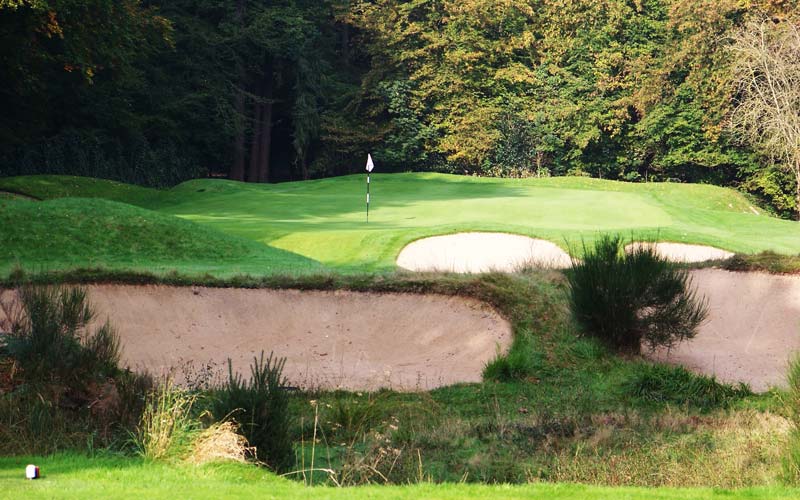
Even for a Colt course, the set of par threes is superlative and help make Saint-Germain one of the finest courses in Europe. Pictured above is the 190 yard fifth.
Not all sites are created equal. On rare occasions, architects are given a wonderful site with which to work and their job is ‘not to messit up’ as Bill Coore once said about the opportunity at Sand Hills. On rarer occasions still, they might even turn a ‘nine’ site into a ‘ten’ golf course. Far more frequently, architects are given property with more modest potential and it is their job to create the golfing interest by adding features to the land. Each opportunity represents a different challenge for the architect and each offers its own unique sense of satisfaction for a job well done.
In the case of Harry Colt, he and his firm are associated with over three hundred courses world-wide. Built primarily during a thirty-five year period before he became too weak to travel in the late 1930s, Harry Colt worked with a wide range of properties. Many consider Royal Portrush with its exquisite crumpled links land to be near the ideal canvas. In 1929, Harry Colt made the most of the opportunity as his routing took full advantage of the many natural landforms.
Eight years prior in 1921, Harry Colt faced an entirely different challenge at Saint-Germain, located in the leafy suburb just west of Paris. He was given a 110 acre site with few natural landforms. Indeed, excluding a quarry at the far corner, the high to low point on the property was a mere five feet. Furthermore, a newly constructed rail line bisected the property. From this unpromising start, Harry Colt created one of his finest designs.
To give the featureless land interest, he relied on two primary means. The first was that he employed to great effect the fill created from the construction of the rail line. Many of the course’s most interesting green complexes were built-up using it, including those found at the stellar seventh, tenth, and fourteenth holes. Also, Harry Colt deployed 116 bunkers around the course, making it one of his most heavily bunkered designs. The placement of the bunkers gives the course much of its strategic interest as we see below.
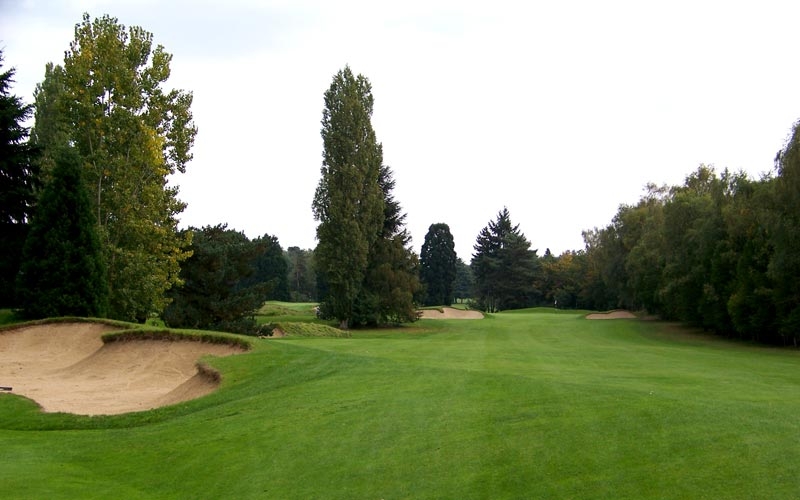
Colt lent the property its playing interest. At the third, for instance, he created a diagonal ridge across the fairway,cutting a bunker into its face. A low tee ball with draw hits the ridge and is fed into it.
Holes to Note
First hole, 430 yards; An atypical hole for Saint-Germain, the golfer sees a long straight fairway that feeds uninterrupted onto the green. Sound easy? Far from it, as out of bounds is down the right and the broad slope of the green’s front third has seen many a golfer start his round by putting, then chipping, then putting again. Like the first at Hoylake, this makes for a superb nineteenth hole.
Second hole, 500 yards; In many ways, the second hole epitomizes the good decisions that have taken place at Saint-Germain in recent times. Back in the mid to late 1990s, a number of new courses were opening across France, putting pressure on the board at Saint-Germain to make sure that their course remained relevant. A few proposals from various architects were entertained, none of which were true to its Harry Colt roots. For instance, one architect called for clover leaf bunkers to be built throughout the course. At this time, a new green was built here at the second, quite large and out of character with Harry Colt‘s other seventeen greens. Sensing a loss, Philippe Delaune, the President of Saint-Germain, reached out for guidance from his friends at such Harry Colt clubs as Sunningdale and Swinley Forest. The resounding message that he received back was to remain faithful to Harry Colt and his design principles. In that vein, rather than trees as had been discussed, a cross hazard was added 220 yards from the second tee in 2001 to help further the dogleg qualities of this hole. Presently, Saint-Germain is also exploring returning the second green to its original Harry Colt design.

Built in-house by Saint-Germain’s talented green keeping crew, the bunker in the foreground gives the second hole strategic interest off the tee. Importantly, it matches Colt’s bunkers farther ahead.
Fourth hole, 460 yards; The first of its great holes, the fourth sweeps to the left with two pairs of bunkers on the inside of the dogleg pushing the golfer to the right. One of the deepest green side bunkers is front right, meaning the golfer dearly loves to approach the green from left of center.Understanding how Harry Colt created such greenside bunker depth on a flat site is to appreciate his enormous talent as a golf course architect.

The closer the tee ball stays to the inside of the dogleg at the fourth, the better.
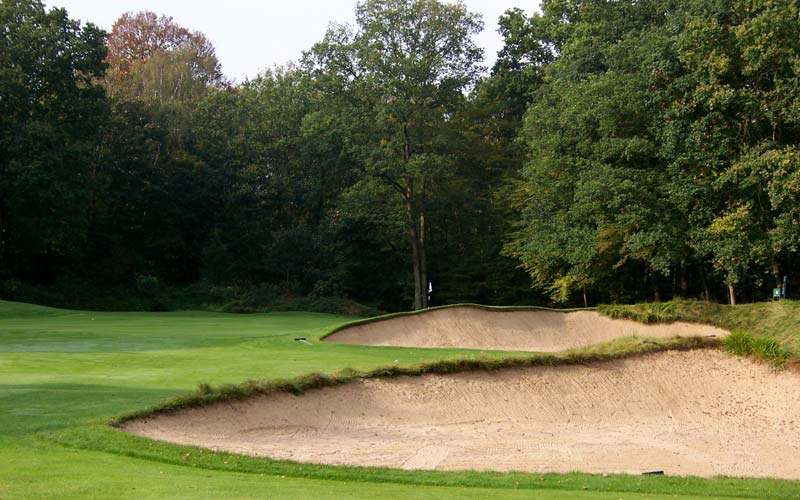
Otherwise, as one goes right off the tee, the angle of approach into the green becomes progressively worse. Note the fifth tee box at the right edge of the photograph. By tying in the bunker off the back of the built-up tee box, Colt cleverly created bunker depth on a flat site.
Fifth hole, 190 yards; When routing a course, Harry Colt famously located the par three holes first. Not surprisingly, that means he designed and built as many standout par threes as any architect. However, what is surprising is that this one, built over flat land, might well be worthy of inclusion on an eclectic list of Harry Colt‘s eighteen finest holes. In regards toits merits,Stuart Hallett, former assistant Green Keeper at Saint-Germain and now head of Stuart Hallett Golf Design, eloquently captures the genius that Harry Colt poured into this hole when he writes,
The setting is beautifully created from extensive cut & fill. The raised tee and green create movement not only around the green, but also the quarry type environment from tee to green that breaks up the dead ground with imagination. At190 yards from the back, the shot is made to look much more difficult than it actually is. At approximately95 yards,two bunkers form the face of the false quarry, full of broom and natural scrub. The two bunkers plus scrub hide just enough to make the hole perspective interesting with the blind fairway adding difficulty to distance evaluation.The fairway itself feeds downhill into a fairway bunker at 155yards that appears much closer to the green when standing on the tee. This key bunker tricks the player into playing the full distance to the flag with a long iron rather than safely flying the bunker with a shorter club and relying on the firm and generous green entrance to run the ball towards the flag for a safe par. The temptation to hit a full length shot into a narrow, two-tiered green leaves no margin for error. The deep grassy hollow to the right of the green makes saving par a severe test, as do recovery shots from the left where two greenside bunkers may save you from the out-of-bounds, approximately 10 yards from the green.The beauty of the hole comes with local knowledge when the duffer option becomes more than just a bail out option. A punchy running shot must fly the first two quarry bunkers and a diagonal mound that masks the green entrance to pitch at approximately 135 yards.Mounding and fairway slopes will send the ball dangerously close to the bunker short of the green. However, by choosing the right landing zone, shot trajectory, and of course careful shot execution ensure a funnel type green entrance and a gentle run uphill towards the center of the green.

The all world fifth with its two short bunkers in the foreground and a third one in the distance that is actually thirty-five yards from the front of the putting surface.
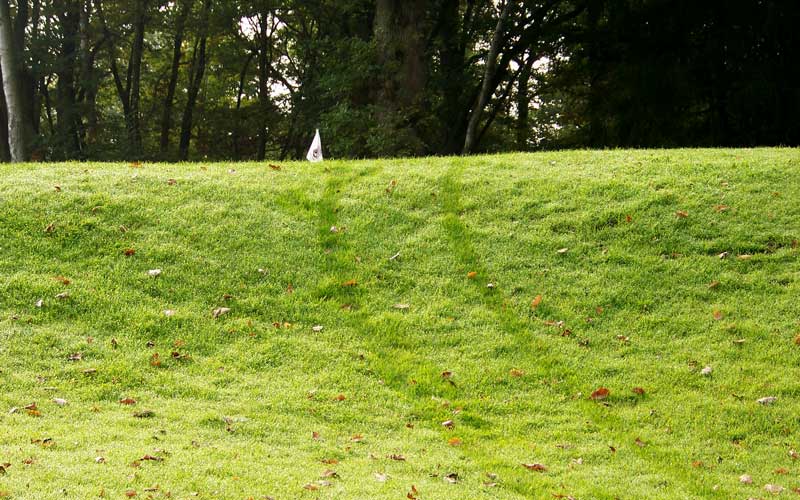
Not immediately evident from the tee is this deep grass swale located to the right of the fifth green.
Sixth hole, 575 yards; Harry Colt utilized bunkers at Saint-Germain to accomplish several different purposes. In this case, Harry Colt built a string of cross bunkers only a one hundred and ten yards from the tee but they accomplish their goal admirably well: they obscure what would otherwise be a fairly prosaic view of a flat field while at the same time providing a thrill to golfers who delight in seeing their tee ball carry the scruffy hazards.
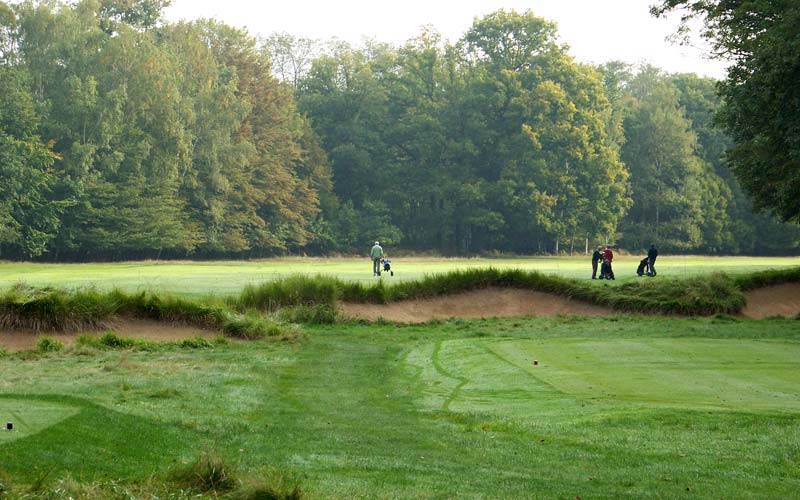
Though close to the tee, these cross bunkers at the sixth add to the allure of playing the hole.
Seventh hole, 180 yards; The most pronounced green pads at Saint-Germain are typically near the rail line which comes as no surprise as that is where the dirt was. The one at the seventh is a particular doozey, with its seven foot false front having confounded golfers for decades.

The one shot seventh features cross bunkers and a…

…wicked false front. Having just repaired his ball mark, the golfer ponders how to play his next shot.
Eighth hole, 360 yards; After playing a round, the golfer is surprised to learn that Saint-Germain is on a relatively tight piece of property as many of its holes enjoy a spaciousness and seclusion not readily associated with just 110 acres. The eighth is such a hole with mounds and trees perfectly used to channel the golfer’s eye toward the green. As recently as 2000, Saint-Germain lacked the strategic interest it currently enjoys as trees rather than bunkers frequently dictated play. With trees encroaching too far in, the playing corridors became narrow and the sole question asked of the golfer was if he could execute one straight drive after another. Fortuitously, a severe winter storm felled several hundred trees on December 26th, 1999.Though original viewed as a disaster, Club officials were quick to appreciate the open views left in the storm’s wake.Ever since that fateful winter, a discreet but determined tree removal program has continued to open up the course, removing unsuitable species that had been introduced over the past several decades. A direct result is the excellent turf quality which Saint-Germain now enjoys, thanks to improved light and air flow.
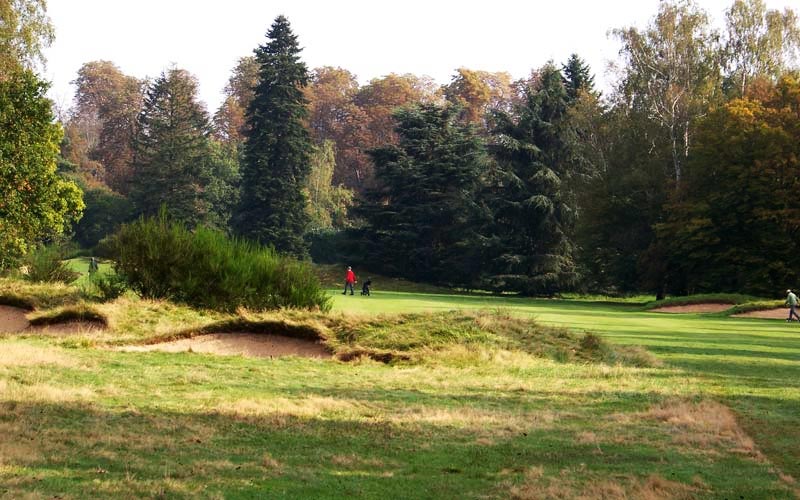
The golfer is blissfully unaware that the eighth fairway is bordered on its left by the second hole and on its right by the tenth.
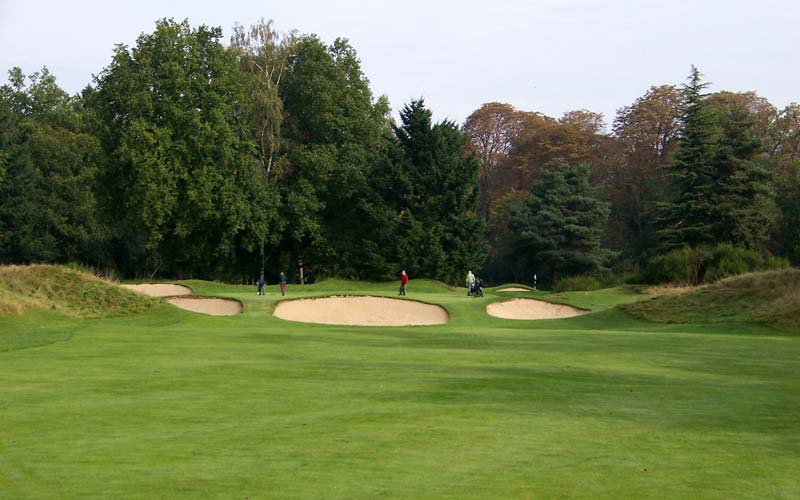
Note how Colt used mounds left and right to funnel the golfer’s eye toward the eighth green.
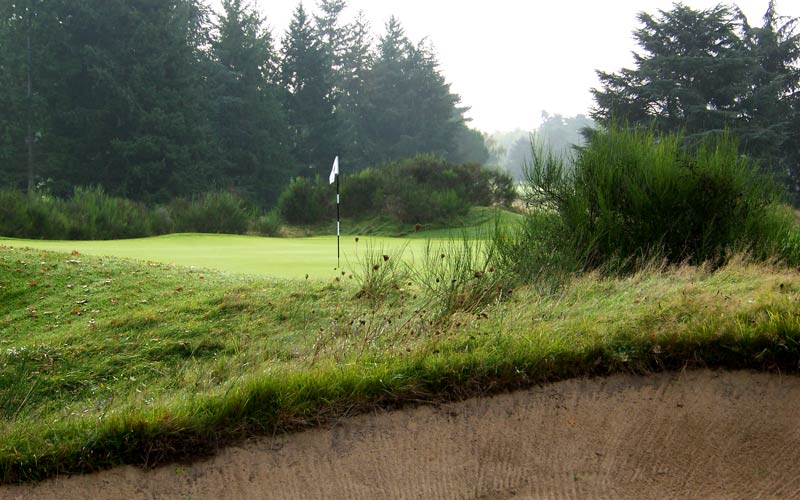
Given its rugged charm, it is hard to believe that Saint-Germain lies just thirty minutes west of Paris. This view is from the left of the eighth green.
Golf de Saint-Germain Saint-Germain-en-Laye
France
Tenth hole, 365 yards; The surest way to defend par of a short to medium length par four is at the green. By doing so, the hole never loses its challenge, despite changes in technology. At the tenth, Colt took the fill from the rail line and built up the green seven feet from its surrounds. Seth Raynor would have referred to this as his Knoll green. The club has extended the tees back forty yards since Colt’s day but golfers are capable of driving the ball eighty yards farther today with 460cc drivers and composite shafts than they were with hickory clubs when the course opened. Regardless, the hole’s challenge remains just as rigorous today thanks to its fortress-like green.
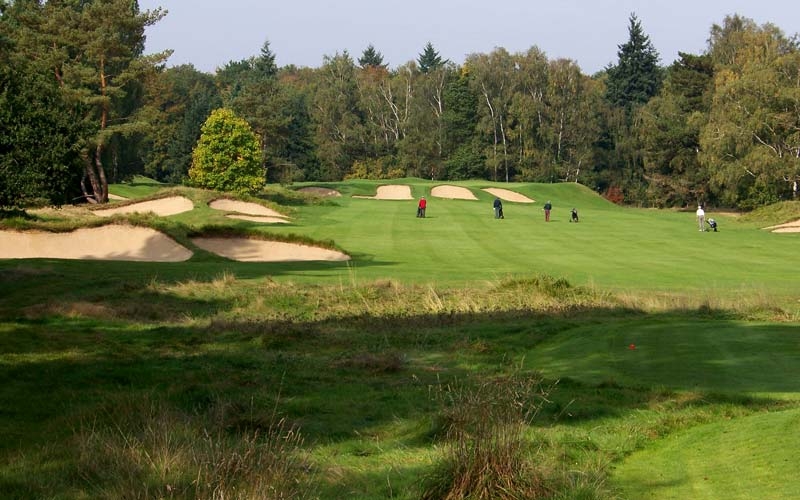
A view down the tenth fairway.
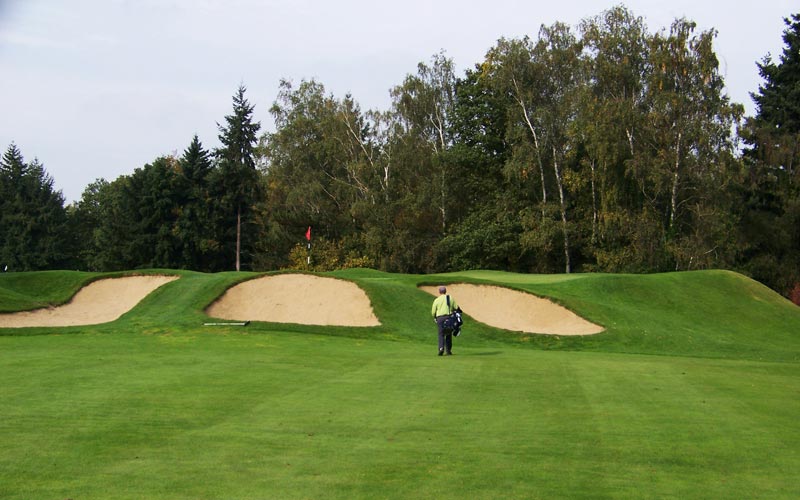
In what was once a flat field, Colt built green complexes of enormous interest and challenge.
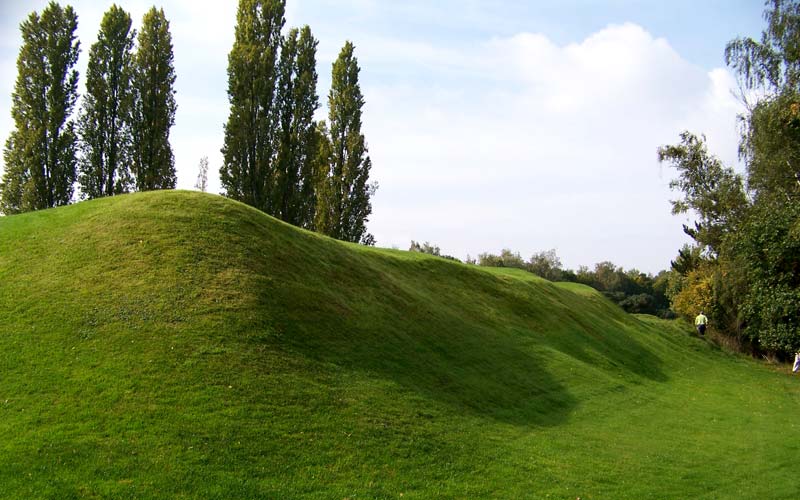
This view from behind the tenth green shows how much Colt built up the green pad.
Eleventh hole, 155 yards; Though it is true that Saint-Germain doesn’t have any weak holes, it nonetheless would not be a standout course without, by definition, standout holes. Taken as a set, its quartet of par threes is truly special. Though not as dramatic as the other three, the eleventh is just as bedeviling, thanks to the seven bunkers that ring the green which slopes slightly away from the tee.
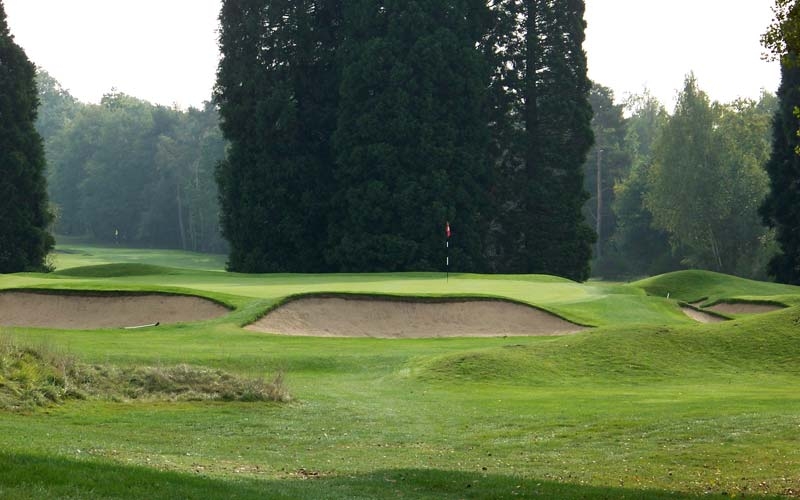
The one shot eleventh.
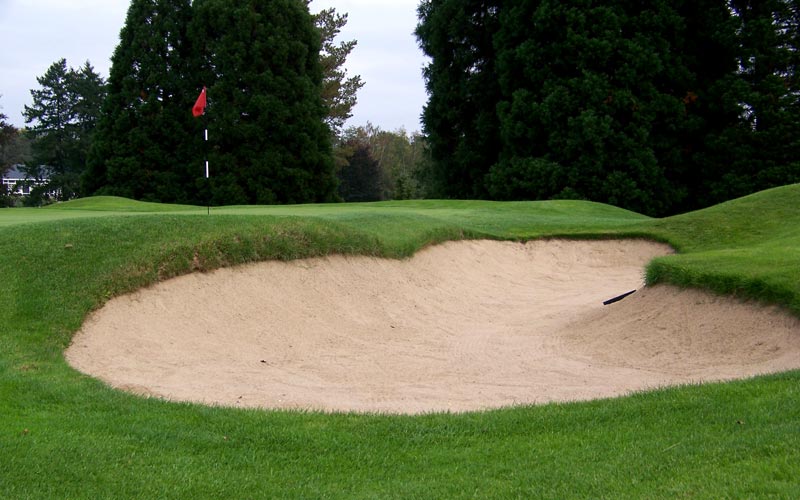
Though it doesn’t look as fearsome as many on the course, this bunker (dubbed the ‘coffin’ by members) to the right of the eleventh green makes for a difficult recovery, especially in its narrow back half.
Thirteenth hole, 340 yards; On a course famed for its bunkers, the thirteenth stands out for its lack of them. With bunkers acting as visual guideposts for what to do/not to do off many of the tees, the absence of bunkers in the hitting area off the thirteenth tee tends to relax the golfer. Also, the green itself seems curiously devoid of bunkers. The overall effect is that the golfer swings merrily away from the tee, not appreciating a) that the long and none too wide green best accepts approach shots from left of center and b) the three foot deep grass swale to the right of the green. Only after carding and having failed to get up and own from the swale does the golfer begin to appreciate that the lack of guidance from the architect was used to great affect on this modest length hole.
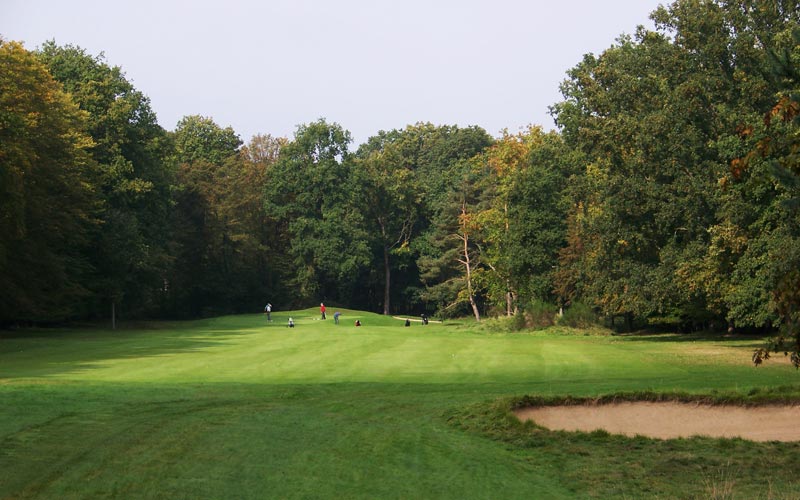
The thirteenth looks innocuous from the tee but many approach shots end up in the grass swale to the right of the green.
Fourteenth hole, 445 yards; In contrast to the subtle thirteenth, the terrors of the fourteenth are immediately evident. Originally a par five when the course opened, ominous bunkers pinch in the fairway one hundred yards from the green and still are a factor for those that miss the fairway with their tee ball. The approach calls for a low flighted ball that runs onto the forty yard deep green. Though open in front, the green runs uphill as an extension of the fairway with two distinct tiers on the putting surface. The back of the green is nearly six feet above the level of the fairway and it is this elevation that makes recovery from grass bunkers on either side so tricky.
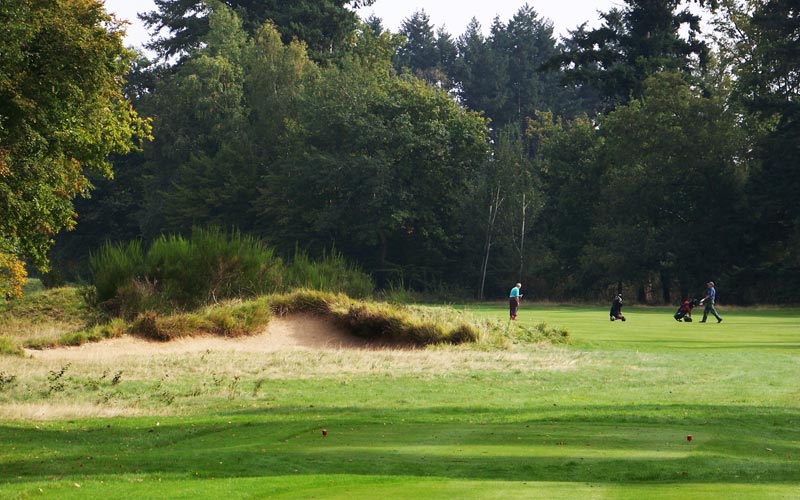
As seen from the fourteenth tee, Saint-Germain’s superb maintenance practices give the course a rich texture that few parkland courses can match. The temptation to bite off too much from the tee on this dogleg left must be avoided as thick scrub, natural fescue, a nest of bunkers and overhanging trees block the approach when in the rough.
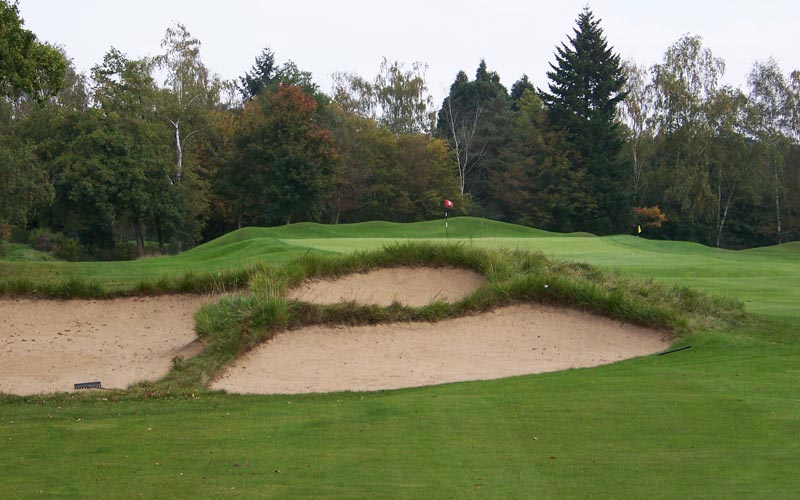
This nest of bunkers is well short of the fourteenth green, which is itself bunkerless.

This side view of the fourteenth green indicates the huge amount of dirt that Colt required to build up its long green pad.
Fifteenth hole, 525 yards; Random land movements lead to a variety of holes and therefore, flat courses generally suffer in comparison with courses with rolling topography. That is not true in the case of Saint-Germain, whose variety of holes is a testament to Colt’s talent as an architect. Take this hole for instance. Needing fill for green pads, Colt elected to create two depressions in the ground, the first one from 220 to 270 off the tee along the right and the second one 150 yards from the green on the left. The golfer needs to zigzag his way down this long fairway without getting caught in either depression. As these two features are below the grade of the land, they appear natural.
Sixteenth hole, 320 yards; The game has seen enormous change since Colt first built Saint-Germain for hickory golf clubs. Despite the advance of technology, Saint-Germain has held up very well. Indeed, the sixteenth might be a better hole today than when it was first laid out as today’s equipment brings the green nearly in reach for long hitters. The temptation to over swing in having a go for this green must be resisted as the trouble comes when golfers press for too much from this tee.
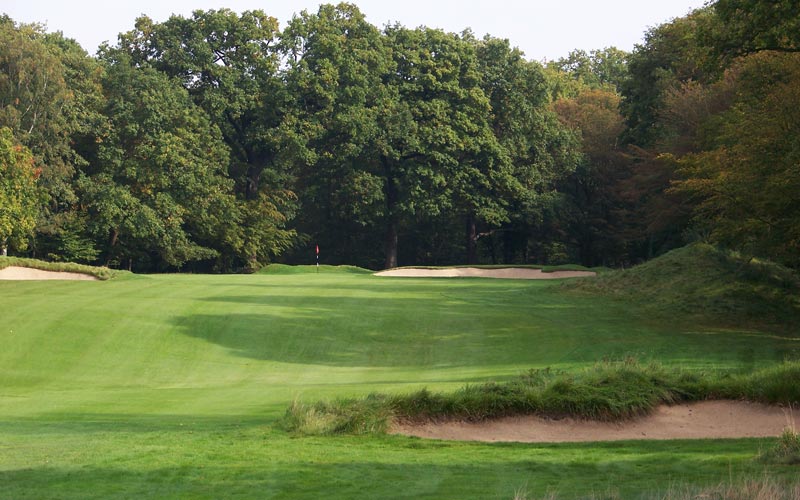
The tempting view from the tee of the drivable sixteenth. The large grass covered mound right and bunker forty yards short left of the green were added by the club in 2006, successfully giving long hitters much upon which to think.
Seventeenth and eighteenth holes, 155 and 445 yards respectively; Located in the corner of the property, a quarry was put to great use by Colt and allows this stylish course to finish with panache. At the seventeenth, he benched the tee area into the hillside and then built-up a green pad on the far side of the quarry. By doing so, Colt also left enough room for the drive off the eighteenth tee to play over the quarry. The last fifty yards of the eighteenth highlight the immeasurable benefit that Saint-Germain receives from being so well presented by Green Keeper Jean Marc Legrand and his crew. The ground gently slopes toward the green and the uniformly fast and firm playing conditions allow the golfer of today to still play a low running shot as Colt intended.
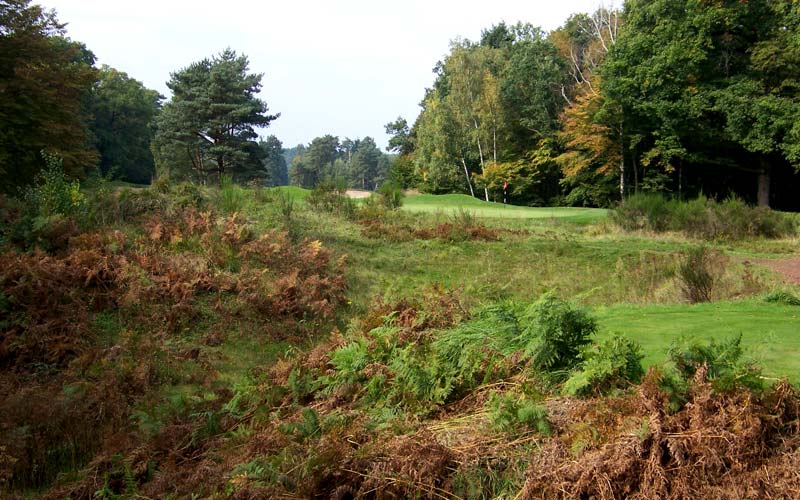
The one shot seventeenth plays across a quarry.
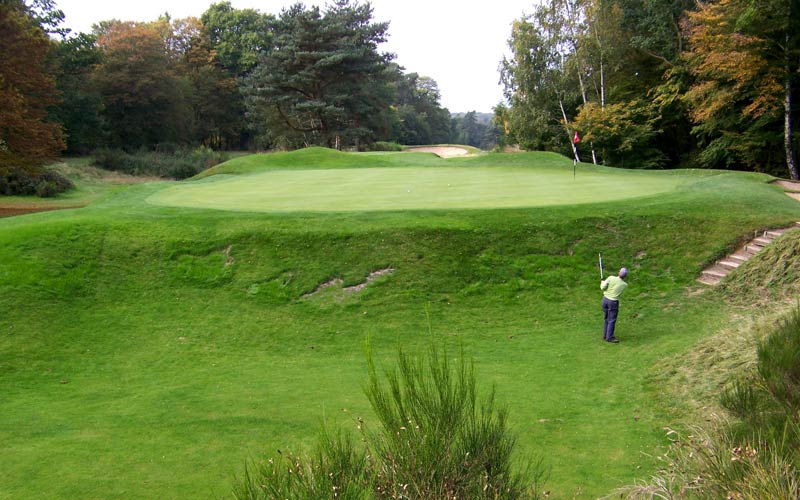
This tee ball at the seventeenth fell short of the green, leaving a difficult recovery.
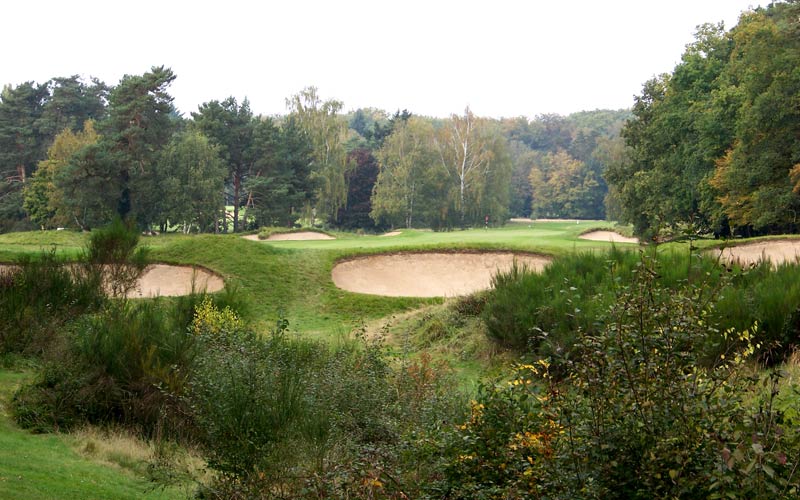
The final tee ball is a thrilling one across the quarry to a wide fairway.
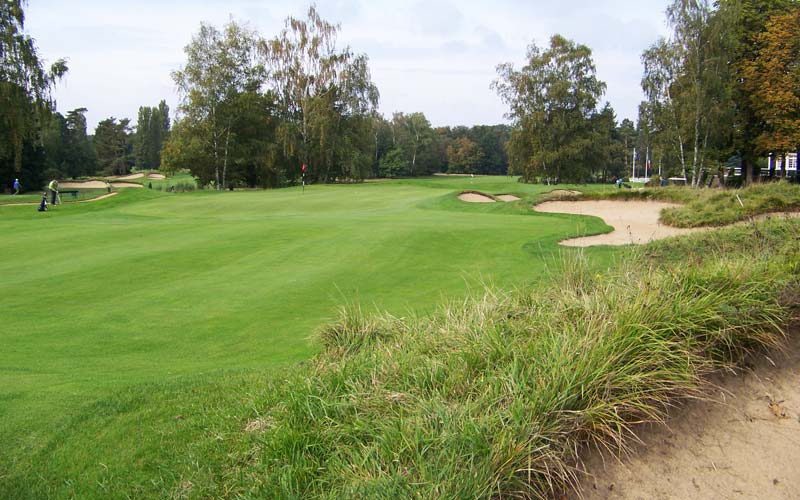
Can the golfer chase an approach past this string of bunkers and onto the eighteenth green? The ground is guaranteed to be firm enough to give it a try.
Saint-Germain hosted the French Open nine times, from 1927 through 1985. Such luminaries as Bobby Locke (1952), Sandy Lyle (1981) and Seve Ballesteros (1985) won here. As the game transitioned from hickory shaft clubs to steel and then with the improvements in agronomy, the winning score was lower with each subsequent French Open. As the course property is hemmed in on all sides by a national forest, it lost the ability to continue to expand. Regardless, its present length of 6,750 yards packs plenty of challenge for its well heeled members. Those fortunate to play here today will no doubt share the same sentiments of admiration as expressed by Bob Jones and Ben Hogan after they played their respective matches here.
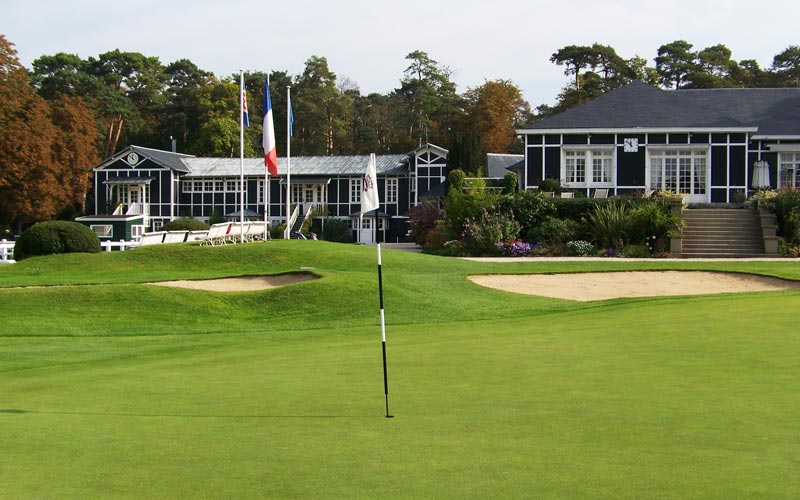
The French flag is between the putting green and the first tee. The clubhouse provides grand views of play on the ninth green.
The End


